 Introduction and
Introduction and
Information
(Home)
Home 2
FAQ/Contacts
Pre-Raphaelite
& Mediaeval
Contemporary
Bridal Gowns
Corsets/Stays
The William Morris
Collection
Classical Tutus
& Dance Costume
16th and 17th Century
18th and 19th Century
Ready-to-Wear
Accessories
Design Process
Sample Sale
Experience
File
|
| 18th
Century Venetian Ball Gown |
"Midnight Blue" |
|

Wendy planned to attend the 2008 Venice Carnival resplendent in eighteenth century historical costume. She chose to have a gown and hooded cloak made-to-measure, rather than taking the risk of hiring a costume once in Venice.Inspired by such sources as the films "Casanova" (BBC) and "Dangerous Liaisons", we evolved a classic eighteenth century style ballgown which would flatter Wendy's stature (five foot) without overpowering her with excesses of ornamentation and embellishment. This style of period gown can be worn over a fully boned corset or the bodice of the gown itself can be boned instead - this is what we opted for, and is how professional film and theatre costumes are often constructed. The gown shown is worn over small pocket hoops. It would be possible to create a larger more elaborate skirt over panniers.
|
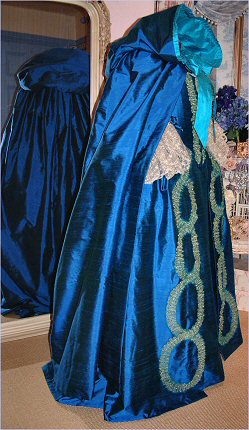 |
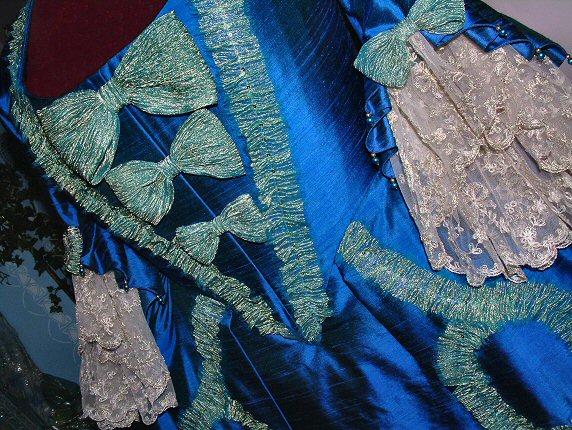 |
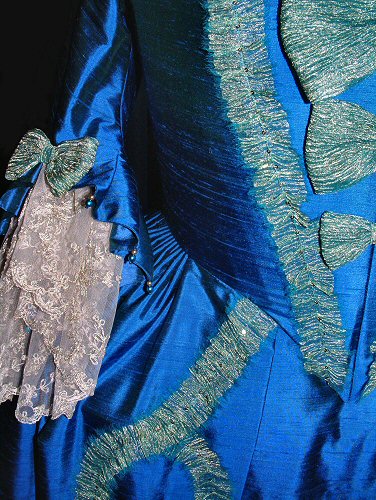 All in a rich sapphire blue/ green shot silk dupion,the fully boned bodice, working as a corset with back lacing, is attached to a sumptuous overskirt, embellished and beaded with gold spangles. Elbow length sleeves, typical of the period end in gold lace sleeve falls. The neckline trim and multiple "figure-of-eight" skirt embellishments are in a pleated turquoise/ gold metallic organza. The skirt and cloak finish at the floor without trains - for the practicality of getting in and out of gondolas! Shown below is the evolution of Wendy's order, including images of her in candle-lit palazzi in the heart of 18th century Venice. (Thank you Wendy!) |
| If you appreciate decoration, this is a style to enjoy!
Possibilities for embellishment are endless - trimmings can be applied to the edge of the bodice, skirt, petticoats and the stomacher. These can be frilled, pleated, ruched, beaded or embroidered and lace and ribbons were very popular at the time. It is not necessary to have a distinct contrast - self-coloured decoration is very effective. 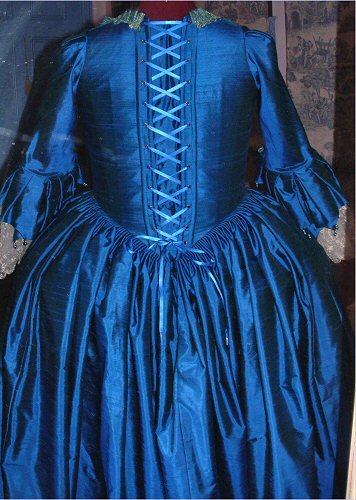
|
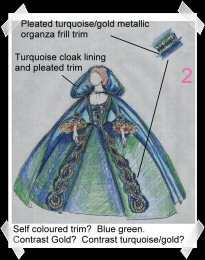 One of half a dozen design variations sent to the client - still keeping options open, but establishing estimated costs. Main fabrics were chosen at the initial consultation. |
 Prepared toile and bucket panniers, ready for the first fitting. |
 The fitted corset/ bodice toile; trying on the underskirt; experimenting with decoration variations - and wigs! |
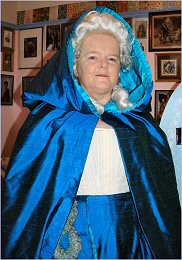 Initially torn between the blue/green silk and a beautiful shade of turquoise for the main gown, we were able to incorporate the turquoise shade to line and trim the cloak. |
 Considering the fitted toile after the fitting. It will now be turned into a pattern which will be a perfect duplicate of the client's shape. |
 The basic eighteenth century boned bodice/corset (cut from the toile), shown over the silk underskirt. |
 The back of the underskirt is not made of silk! Just as with an 18th century gentleman's elaborately embroidered waistcoat, the back - which will not be seen - is plain and functional. |
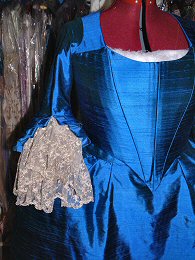 The silk sleeves are made up in their entirety: linings, scalloped cuffs and lace falls, before they are put into the armholes. |
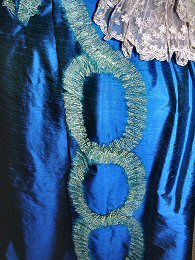 Pleated metallic organza in figures-of-eight edge the sides of the overskirt. |
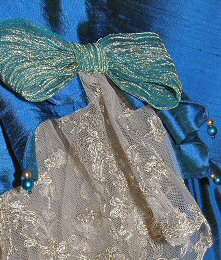 The sleeve falls are in a pretty gold and ivory lace, ornamented with bows at the elbow. |
 The overskirt is attached to the boned bodice with cartridge pleating. |
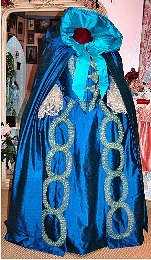 The completed eighteenth century costume with matching cape. |
 |
 |

This design can be varied and individualised
to each made-to-measure order. |
Copyright © 2007 - 2008 Theresa Blake. All Rights Reserved.
|

